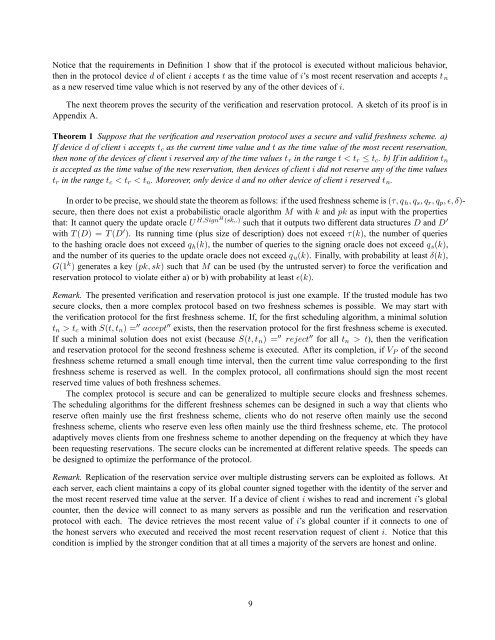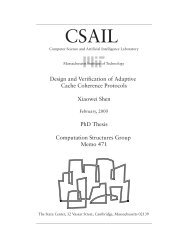Proof of Freshness - Computation Structures Group - MIT
Proof of Freshness - Computation Structures Group - MIT
Proof of Freshness - Computation Structures Group - MIT
You also want an ePaper? Increase the reach of your titles
YUMPU automatically turns print PDFs into web optimized ePapers that Google loves.
Notice that the requirements in Definition 1 show that if the protocol is executed without malicious behavior,<br />
then in the protocol device d <strong>of</strong> client i accepts t as the time value <strong>of</strong> i’s most recent reservation and accepts t n<br />
as a new reserved time value which is not reserved by any <strong>of</strong> the other devices <strong>of</strong> i.<br />
The next theorem proves the security <strong>of</strong> the verification and reservation protocol. A sketch <strong>of</strong> its pro<strong>of</strong> is in<br />
Appendix A.<br />
Theorem 1 Suppose that the verification and reservation protocol uses a secure and valid freshness scheme. a)<br />
If device d <strong>of</strong> client i accepts tc as the current time value and t as the time value <strong>of</strong> the most recent reservation,<br />
then none <strong>of</strong> the devices <strong>of</strong> client i reserved any <strong>of</strong> the time values tr in the range t < tr ≤ tc. b) If in addition tn<br />
is accepted as the time value <strong>of</strong> the new reservation, then devices <strong>of</strong> client i did not reserve any <strong>of</strong> the time values<br />
tr in the range tc < tr < tn. Moreover, only device d and no other device <strong>of</strong> client i reserved tn.<br />
In order to be precise, we should state the theorem as follows: if the used freshness scheme is (τ, qh, qs, qr, qp, ɛ, δ)secure,<br />
then there does not exist a probabilistic oracle algorithm M with k and pk as input with the properties<br />
that: It cannot query the update oracle U H,SignH (sk,.) such that it outputs two different data structures D and D ′<br />
with T (D) = T (D ′ ). Its running time (plus size <strong>of</strong> description) does not exceed τ(k), the number <strong>of</strong> queries<br />
to the hashing oracle does not exceed qh(k), the number <strong>of</strong> queries to the signing oracle does not exceed qs(k),<br />
and the number <strong>of</strong> its queries to the update oracle does not exceed qu(k). Finally, with probability at least δ(k),<br />
G(1 k ) generates a key (pk, sk) such that M can be used (by the untrusted server) to force the verification and<br />
reservation protocol to violate either a) or b) with probability at least ɛ(k).<br />
Remark. The presented verification and reservation protocol is just one example. If the trusted module has two<br />
secure clocks, then a more complex protocol based on two freshness schemes is possible. We may start with<br />
the verification protocol for the first freshness scheme. If, for the first scheduling algorithm, a minimal solution<br />
tn > tc with S(t, tn) = ′′ accept ′′ exists, then the reservation protocol for the first freshness scheme is executed.<br />
If such a minimal solution does not exist (because S(t, tn) = ′′ reject ′′ for all tn > t), then the verification<br />
and reservation protocol for the second freshness scheme is executed. After its completion, if VP <strong>of</strong> the second<br />
freshness scheme returned a small enough time interval, then the current time value corresponding to the first<br />
freshness scheme is reserved as well. In the complex protocol, all confirmations should sign the most recent<br />
reserved time values <strong>of</strong> both freshness schemes.<br />
The complex protocol is secure and can be generalized to multiple secure clocks and freshness schemes.<br />
The scheduling algorithms for the different freshness schemes can be designed in such a way that clients who<br />
reserve <strong>of</strong>ten mainly use the first freshness scheme, clients who do not reserve <strong>of</strong>ten mainly use the second<br />
freshness scheme, clients who reserve even less <strong>of</strong>ten mainly use the third freshness scheme, etc. The protocol<br />
adaptively moves clients from one freshness scheme to another depending on the frequency at which they have<br />
been requesting reservations. The secure clocks can be incremented at different relative speeds. The speeds can<br />
be designed to optimize the performance <strong>of</strong> the protocol.<br />
Remark. Replication <strong>of</strong> the reservation service over multiple distrusting servers can be exploited as follows. At<br />
each server, each client maintains a copy <strong>of</strong> its global counter signed together with the identity <strong>of</strong> the server and<br />
the most recent reserved time value at the server. If a device <strong>of</strong> client i wishes to read and increment i’s global<br />
counter, then the device will connect to as many servers as possible and run the verification and reservation<br />
protocol with each. The device retrieves the most recent value <strong>of</strong> i’s global counter if it connects to one <strong>of</strong><br />
the honest servers who executed and received the most recent reservation request <strong>of</strong> client i. Notice that this<br />
condition is implied by the stronger condition that at all times a majority <strong>of</strong> the servers are honest and online.<br />
9
















